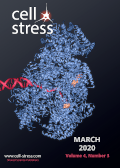Table of contents
Volume 4, Issue 3, pp. 48 - 65, March 2020
Cover: This month in
Cell Stress: DNA helicases in genome stability. Image depicts structure of eukaryotic CMG helicase at a replication fork. PDB ID: 5U8S. Georgescu, R., Yuan, Z., Bai, L., de Luna Almeida Santos, R., Sun, J., Zhang, D., Yurieva, O., Li, H., O'Donnell, M.E. (2017) Structure of eukaryotic CMG helicase at a replication fork and implications to replisome architecture and origin initiation. Proc. Natl. Acad. Sci. U.S.A. 114: E697-E706. Modified by
Cell Stress.The cover is published under the
CC BY 4.0 license.
Enlarge issue cover
RPA and Pif1 cooperate to remove G-rich structures at both leading and lagging strand
Laetitia Maestroni, Julien Audry, Pierre Luciano, Stéphane Coulon, Vincent Géli and Yves Corda
Research Articles |
page 48-63 | 10.15698/cst2020.03.214 | Full text | PDF |
Abstract
In Saccharomyces cerevisiae, the absence of Pif1 helicase induces the instability of G4-containing CEB1 minisatellite during leading strand but not lagging strand replication. We report that RPA and Pif1 cooperate to maintain CEB1 stability when the G4 forming strand is either on the leading or lagging strand templates. At the leading strand, RPA acts in the same pathway as Pif1 to maintain CEB1 stability. Consistent with this result, RPA co-precipitates with Pif1. This association between Pif1 and RPA is affected by the rfa1-D228Y mutation that lowers the affinity of RPA in particular for G-rich single-stranded DNA. At the lagging strand, in contrast to pif1∆, the rfa1-D228Y mutation strongly increases the frequency of CEB1 rearrangements. We explain that Pif1 is dispensable at the lagging strand DNA by the ability of RPA by itself to prevent formation of stable G-rich secondary structures during lagging strand synthesis. Remarkably, overexpression of Pif1 rescues the instability of CEB1 at the lagging strand in the rfa1-D228Y mutant indicating that Pif1 can also act at the lagging strand. We show that the effects of the rfa1-D228Y (rpa1-D223Y in fission yeast) are conserved in Schizosaccharomyces pombe. Finally, we report that RNase H1 interacts in a DNA-dependent manner with RPA in budding yeast, however overexpression of RNase H1 does not rescue CEB1 instability observed in pif1∆ and rfa1-D228Y mutants. Collectively these results add new insights about the general role of RPA in preventing formation of DNA secondary structures and in coordinating the action of factors aimed at resolving them.
Biomechanical stress regulates mammalian tooth replacement
Xiaoshan Wu and Songlin Wang
Microreviews |
page 64-65 | 10.15698/cst2020.03.215 | Full text | PDF |
Abstract
Cyclical renewal of integumentary organs, including hair, feathers, and teeth occurs throughout an organism’s lifetime. Transition from the resting to the initiation stage is critical for each cycle, but the mechanism remains largely unknown. Humans have two sets of dentitions—deciduous and permanent—and tooth replacement occurs only once. Prior to eruption of the permanent tooth (PT), the successional dental lamina (SDL) of the PT can be detected as early as the embryonic stage, even though it then takes about 6–12 years for the SDL to develop to late bell stage. Little is known about the mechanism by which resting SDL transitions into the initiation stage inside the mandible. As a large mammal, the miniature pig, which is also a diphyodont, was a suitable model for our recent study (EMBO J (2020)39: e102374). Using this model, we found that the SDL of PT did not begin the transition into the bud stage until the deciduous tooth (DT) began to erupt.



